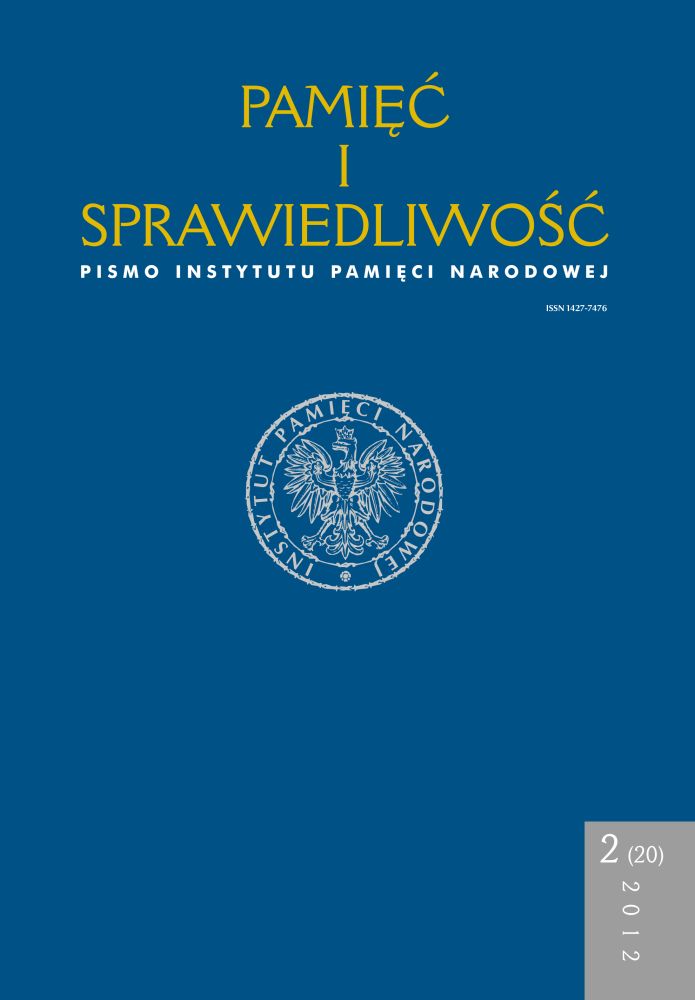Drogi i bezdroża młodzieżowej konspiracji. Klub Wykolejeńców (1950–1951) w świetle dokumentacji tajnej policji politycznej Polski Ludowej
Pamięć i Sprawiedliwość, Tom 20 Nr 2 (2012), strony: 261-280
Data publikacji: 2012-12-30
Abstrakt
Bibliografia
J. Wołoszyn, Konspiracja młodzieżowa na ziemiach polskich w latach 1944–1956, „Pamięć i Sprawiedliwość” 2011, nr 17, s. 47-74. B. Skaradziński, Wronki–Warszawa–Wronki. Wspominki kombatanta niebohaterskiego, Zeszyty Historyczne 1995, nr 113, s. 67-90. J. Blikowska, M. Kozubal, Żołnierz wyklęty dwa razy, „Uważam Rze. Inaczej Pisane” 2011, nr 7, s. 30. J. Wołk-Łaniewski, To też Polska [w:] Jesteśmy z Batorego. Wspomnienia absolwentów gimnazjum i liceum im. Stefana Batorego w Warszawie – głównie z rocznika maturalnego 1951, red. B. Bartnikowski, Z. Boniecki, Z. Sadłowski, b.d.m.w., s. 298. Z. Pietrzak, Długoletni Batorak [w:] Jesteśmy z Batorego. Wspomnienia absolwentów gimnazjum i liceum im. Stefana Batorego w Warszawie – głównie z rocznika maturalnego 1951, red. B. Bartnikowski, Z. Boniecki, Z. Sadłowski, b.d.m.w., s. 221. Z. Romek, Walka z „amerykańskim zagrożeniem” w okresie stalinowskim, „Polska 1944/45-1989. Studia i Materiały” 2001, t. 5, s. 209 . H. Świda-Ziemba, Młodzież PRL. Portrety pokoleń w kontekście historii, Kraków 2010, K. Krajewski, T. Łabuszewski, J. Pawłowicz, Niepodległościowe organizacje młodzieżowe VII 1944 – XII 1956 [w:] Atlas polskiego podziemia niepodległościowego 1944–1956, red. R. Wnuk i inni, Warszawa–Lublin 2007, s. 264. K. Krajewski, Załącznik do artykułu Konspiracyjne organizacje młodzieżowe na terenie województwa mazowieckiego w latach 1945–1956 [w:] „Jesteście naszą wielką szansą”. Młodzież na rozstajach komunizmu 1944–1989, red. P. Ceranka i S. Stępień, Warszawa 2009, s. 189.
Inne teksty tego samego autora
- Bartłomiej Noszczak, Przesiedlenie żeńskich zgromadzeń zakonnych z województw katowickiego, opolskiego i wrocławskiego (sierpień 1954) , Pamięć i Sprawiedliwość: Tom 9 Nr 1 (2006)
- Bartłomiej Noszczak, Na początku był bunt. Federacja Młodzieży Walczącej w Warszawie (1984–1989) , Pamięć i Sprawiedliwość: Tom 19 Nr 1 (2012)
- Bartłomiej Noszczak, Solidarność poznaniaków. Komitet Studenckiej Pomocy dla Więźniów Politycznych i jego kontynuacja w postaci akcji "rodzin zastępczych" (1956-1959) , Pamięć i Sprawiedliwość: Tom 28 Nr 2 (2016)
- Bartłomiej Noszczak, Kryzys działalności Departamentu VI KdsBP przeciwko Kościołowi rzymskokatolickiemu w Polsce i próby jego przezwyciężenia (1954–1956) , Pamięć i Sprawiedliwość: Tom 7 Nr 1 (2005)
- Bartłomiej Noszczak, Antykościelna międzynarodówka. Współpraca polskiego Urzędu do spraw Wyznań z jego odpowiednikami w państwach „demokracji ludowej” (1954–1962) , Pamięć i Sprawiedliwość: Tom 33 Nr 1 (2019)
- Bartłomiej Noszczak, Nobel za Orędzie? List o. Stanisława Wawryna SJ do prymasa Stefana Wyszyńskiego w sprawie możliwości przyznania Episkopatowi Polski Pokojowej Nagrody Nobla za wystosowanie Orędzia do biskupów niemieckich , Pamięć i Sprawiedliwość: Tom 30 Nr 2 (2017)
 Język Polski
Język Polski
 English
English
 Deutsch
Deutsch
 Français (France)
Français (France)
 Italiano
Italiano
 Русский
Русский


 PDF
PDF
